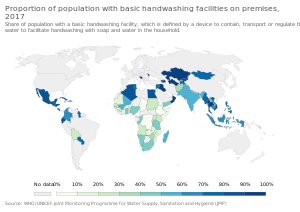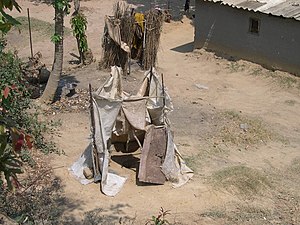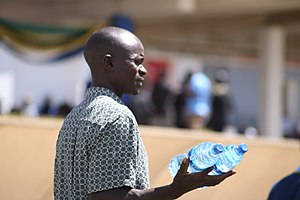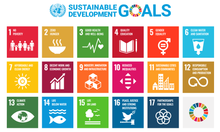Sustainable Development Goal 6
| Sustainable Development Goal 6 | |
|---|---|
 | |
| Mission statement | "Ensure availability and sustainable management of water and sanitation for all" |
| Commercial? | No |
| Type of project | Non-Profit |
| Location | Global |
| Owner | Supported by United Nation & Owned by community |
| Founder | United Nations |
| Established | 2015 |
| Website | sdgs |
Sustainable Development Goal 6 (SDG 6 or Global Goal 6) is about "clean water and sanitation for all." It is one of 17 Sustainable Development Goals established by the United Nations General Assembly in 2015, the official wording is: "Ensure availability and sustainable management of water and sanitation for all."[1] The goal has eight targets to be achieved by at least 2030. Progress toward the targets will be measured by using eleven indicators.[2]
Safe drinking water and hygienic toilets protect people from disease and enable societies to be more productive economically. Attending school and work without disruption supports education and employment. Therefore, toilets at school and at the work place are included in the second target ("achieve access to adequate and equitable sanitation and hygiene for all"). Equitable sanitation and hygiene solutions address the needs of women and girls and those in vulnerable situations, such as the elderly or people with disabilities.
A review of SDG progress by the United Nations in 2020 found that "increasing donor commitments to the water sector will remain crucial to make progress towards Goal 6".[3] This is why the UN has put in place a unifying initiative that improve support to countries known as SDG 6 Global Acceleration Framework.[4] To meet SDG targets for sanitation by 2030, nearly one-third of countries will need to accelerate progress to end open defecation, including Brazil, China, Ethiopia, India, Indonesia, Nigeria, and Pakistan.[5]
SDG 6 is closely linked with other Sustainable Development Goals (SDGs). For example, progress in SDG 6 will improve health (Goal 3) and improve school attendance, both of which contribute to alleviating poverty. In April 2020, United Nations Secretary-General António Guterres said: “Today, Sustainable Development Goal 6 is badly off track" and it “is hindering progress on the 2030 Agenda, the realization of human rights and the achievement of peace and security around the world".[6]
In 2017, 2.2 billion people lacked safely managed drinking water and 4.2 billion people lacked safely managed sanitation.[7] Three billion people worldwide lack basic hand-washing facilities at home.[7] Two in five healthcare facilities world-wide have no soap and water, or alcohol-based hand rub (2016).[7] The COVID-19 pandemic has made this goal increasingly important.[3] However this pandemic could affect the ability of water utilities to meet this goal by increasing losses on revenues that would otherwise be used to make investments.[8]
Background

The UN has determined that access to clean water and sanitation facilities is a basic human right.[9] Over 2 billion people in the world lack access to water that is free of health risks.[10] By 2017, eighty countries provided access to clean water for more than 99% of their population.[11] From 2000 to 2017, the global population that lacked access to clean water decreased from nearly 20% to roughly 10%.[10]
Ending open defecation will require provision of toilets and sanitation for 2.6 billion people as well as behavior change of the population.[12] This will require cooperation between governments, civil society and the private sector.[13]
Targets, indicators and progress



SDG 6 has eight targets. Six of them are to be achieved by the year 2030, one by the year 2020, and one has no target year.[15] Each of the targets also has one or two indicators which will be used to measure progress. In total there are 11 indicators for SDG6.[16] The main data sources for the SDG 6 targets and indicators come from the Integrated Monitoring Initiative for SDG 6 coordinated by UN-Water.[17]
SDG 6 includes eight global targets that are aspirational.[17] Each government must decide how to incorporate them into national planning processes, policies and strategies based on national realities, capacities, levels of development and priorities.[17] The eight targets cover the entire water cycle including: "provision of drinking water (target 6.1) and sanitation and hygiene services (6.2), treatment and reuse of wastewater and ambient water quality (6.3), water-use efficiency and scarcity (6.4), IWRM including through transboundary cooperation (6.5), protecting and restoring water-related ecosystems (6.6), international cooperation and capacity-building (6.a) and participation in water and sanitation management (6.b).[17]
The first three targets relate to drinking water supply, sanitation services and wastewater treatment and reuse.[15]
An SDG 6 Baseline Report in 2018 found that less than 50 per cent of countries have comparable baseline estimates for most SDG 6 global indicators.[17]: 31 One reason is that many SDG 6 global indicators are new, and most have only limited time series, making it difficult to determine rates of progress.[17]: 31
Target 6.1: Safe and affordable drinking water
The full title of Target 6.1 is: "By 2030, achieve universal and equitable access to safe and affordable drinking water for all".[2]
This target has one indicator: Indicator 6.1.1 is the "Proportion of population using safely managed drinking water services".[14]
The definition of "safely managed drinking water service" is: "Drinking water from an improved water source that is located on premises, available when needed and free from fecal and priority chemical contamination."[12]: 8 Between 2000 and 2015, the percentage of global population using safely managed drinking water serviced has increased from 61 to 71 per cent. But this remained unchanged in 2017. In total, 785 million people around the world still lacked basic drinking water service.[18]
In 2017, only 71 per cent of the global population used safely managed drinking water. This means that 2.2 billion persons were still without safely managed drinking water in 2017.[3]
Target 6.2: End open defecation and provide access to sanitation and hygiene
The full title of Target 6.2 is: "By 2030, achieve access to adequate and equitable sanitation and hygiene for all and end open defecation, paying special attention to the needs of women and girls and those in vulnerable situations."[2]
This target has one indicator: Indicator 6.2.1 is the "Proportion of population using (a) safely managed sanitation services and (b) a hand-washing facility with soap and water".[19]
The definition of "safely managed sanitation" service is: "Use of improved facilities that are not shared with other households and where excreta are safely disposed of in situ or transported and treated offsite."[12]: 8 Improved sanitation facilities are those designed to hygienically separate excreta from human contact.[12]: 6
Targets 6.1 and 6.2 are usually reported on together because they are both part of the WASH sector and have the same custodian agency, the Joint Monitoring Program for Water Supply and Sanitation (JMP).[12]
The statistic in the 2017 baseline estimate by the Joint Monitoring Program for Water Supply and Sanitation (JMP) is that 4.5 billion people currently do not have safely managed sanitation.[12]

Globally, the proportion of population using safely managed sanitation services increased from 28 per cent in 2000 to 45 per cent in 2017. Latin America and the Caribbean, sub-Saharan Africa, and East and Southeast Asia recorded the largest increase. In total, there are still 701 million people around the world who still had to practice open defecation in 2017.[18] This number had reduced in 2020 to 673 million persons who practised open defecation.[3]
As of 2017, two-thirds of countries lacked baseline estimates for SDG indicators on hand washing, safely managed drinking water, and sanitation services.[20]
In 2017, about 60 per cent of people worldwide have basic hand-washing facilities with soap and water at home. However, within the least developed countries, only 38 per cent had such facilities, translating to about 3 billion people still without basic hand washing facilities at home.[18]
In 2020, a report by the High-Level Political Forum on Sustainable Development found that "Billions of people throughout the world still lack access to safely managed water and sanitation services and basic handwashing facilities at home, which are critical to preventing the spread of COVID-19".[3] However, this same pandemic has most likely caused a reduction in access to safely managed sanitation.[21]
Target 6.3: Improve water quality, wastewater treatment and safe reuse

Target 6.3 is formulated as "By 2030, improve water quality by reducing pollution, eliminating dumping and minimizing release of hazardous chemicals and materials, halving the proportion of untreated wastewater and substantially increasing recycling and safe reuse globally".[2] This is also a sanitation-related target, as wastewater treatment is part of sanitation.
The target has two indicators:[19]
- Indicator 6.3.1: Proportion of domestic and industrial wastewater flows safely treated
- Indicator 6.3.2: Proportion of bodies of water with good ambient water quality
The current status for Indicator 6.3.2 is that: "Preliminary estimates from 79 mostly high- and higher-middle income countries in 2019 suggest that, in about one quarter of the countries, less than half of all household wastewater flows were treated safely."[3]
Preserving natural sources of water is very important so as to achieve universal access to safe and affordable drinking water.

Target 6.4: Increase water-use efficiency and ensure freshwater supplies
Target 6.4 is formulated as "By 2030, substantially increase water-use efficiency across all sectors and ensure sustainable withdrawals and supply of freshwater to address water scarcity and substantially reduce the number of people suffering from water scarcity."[2]
This target has two indicators:[19]
- Indicator 6.4.1: Change in water-use efficiency over time
- Indicator 6.4.2: Level of water stress: freshwater withdrawal as a proportion of available freshwater resources
The current situation regarding water stress was summarized as follows: "In 2017, Central and Southern Asia and Northern Africa registered very high water stress – defined as the ratio of fresh water withdrawn to total renewable freshwater resources – of more than 70 per cent". This is followed by Western Asia and Eastern Asia, with high water stress of 54 per cent and 46 per cent, respectively.[3]
Target 6.5: Implement IWRM
Target 6.5 is formulated as: "By 2030, implement integrated water resources management at all levels, including through transboundary cooperation as appropriate."[2]
The two indicators include:[19]
- Indicator 6.5.1 Degree of integrated water resources management
- Indicator 6.5.2 Proportion of transboundary basin area with an operational arrangement for water cooperation
A review in 2020 stated that: "In 2018, 60 per cent of 172 countries reported very low, low and medium-low levels of implementation of integrated water resources management and were unlikely to meet the implementation target by 2030."[3]
The same review stated that: "According to data from 67 countries, the average percentage of national transboundary basins covered by an operational arrangement was 59 per cent in the period 2017–2018. Only 17 countries reported that all of their transboundary basins were covered by such arrangements."[3]

Target 6.6 is: "By 2020, protect and restore water-related ecosystems, including mountains, forests, wetlands, rivers, aquifers and lakes."[2]
It has one indicator: Indicator 6.6.1 is the "Change in the extent of water-related ecosystems over time".[19]
It is expected that the adverse effects of climate change can decrease the extent of freshwater bodies, thereby worsening ecosystems and livelihoods.[3]
Target 6.a: Expand water and sanitation support to developing countries
Target 6.a is: "By 2030, expand international cooperation and capacity-building support to developing countries in water- and sanitation-related activities and programmes, including water harvesting, desalination, water efficiency, wastewater treatment, recycling and reuse technologies."[2]
It has one indicator: Indicator 6.a.1 is the "Amount of water- and sanitation-related official development assistance that is part of a government-coordinated spending plan".[19]
In 2019, a document by the UN found that: "Following several years of steady increases and after reaching $9 billion in 2016, official development assistance (ODA) disbursements to the water sector declined by 2 per cent from 2016 to 2017. However, ODA commitments to the water sector jumped by 36 per cent between 2016 and 2017, indicating a renewed focus by donors on the sector."[22]
One year later in April 2020 it was stated that "ODA disbursements to the water sector increased to $9 billion, or 6 per cent, in 2018, following a decrease in such disbursements in 2017".[3]
Target 6.b: Support local engagement in water and sanitation management
Target 6.b is: "Support and strengthen the participation of local communities in improving water and sanitation management."[2]
It has one indicator: Indicator 6.b.1 is the "Proportion of local administrative units with established and operational policies and procedures for participation of local communities in water and sanitation management".[19]
Custodian agencies
Custodian agencies are in charge of reporting on the following indicators:[12][17]
- Indicator 6.1.1 and 6.2.1: Joint Monitoring Programme for Water Supply and Sanitation (JMP). The JMP is a joint program of UNICEF and WHO and compiles data to monitor progress of Target 6.1 and Target 6.2.
- Indicator 6.3.1: UN-Habitat and WHO
- Indicator 6.3.2: Global Environment Monitoring System for Freshwater (GEMS/Water), International Centre for Water Resources and Global Change (UNESCO-IHP); Federal Institute of Hydrology, Germany; University College Cork, Ireland
- Indicators 6.4.1 and 6.4.2: FAOSTAT - AQUASTAT
- Indicator 6.5.1: United Nations Environment Programme-DHI Centre
- Indicator 6.5.2: UNECE and UNESCO-IHP
- Indicator 6.6.1: United Nations Environment Programme, World Conservation Monitoring Centre, International Water Management Institute (IWMI)
- Indicators 6.a.1 and 6.b.1: UN-Water Global Analysis and Assessment of Sanitation and Drinking-Water (GLAAS)
Challenges
Impact of COVID-19 pandemic
The COVID-19 pandemic has greatly affected the urban poor living in the slums with little or no access to clean water. The pandemic has shown the importance of sanitation, hygiene and adequate access to clean water to prevent diseases. According to the World Health Organization, handwashing is one of the most effective actions you can take to reduce the spread of pathogens and prevent infections, including the COVID-19 virus.[23]
The world is being asked to wash hands multiple times in a day, wash and sanitize every object brought from outside, sanitize all public transport at a certain interval in a day.[24] The water consumption, as well as the wastewater generation all across the globe, have now increased manifold. The UN-Habitat is working with partners to facilitate access to running water and handwashing in informal settlements.[23] With the increased exploitation of water resources in 2020 its reported that by 2030 700 million people might be displaced by water scarcity.[25]
Monitoring
High-level progress reports for all the SDGs are published in the form of reports by the United Nations Secretary General. The most recent one is from April 2020.[3] The report before that was from May 2019.[22]
Additionally, updates and progress can also be found on the SDG website that is managed by the United Nations.[26]
Links with other SDGs

The SDGs are highly interdependent. Therefore, the provision of clean water and sanitation for all is a precursor to achieving many of the other SDGs.[27] WASH experts have stated that without progress on Goal 6, the other goals and targets cannot be achieved.[28][29]
For example, sanitation improvements can lead to more jobs (SDG 8) which would also lead to economic growth.[30] SDG 6 progress improves health (SDG 3) and social justice (SDG 16).[31] Recovering the resources embedded in excreta and wastewater (like nutrients, water and energy) contributes to achieving SDG 12 (sustainable consumption and production) and SDG 2 (end hunger). Ensuring adequate sanitation and wastewater management along the entire value chain in cities contributes to SDG 11 (sustainable cities and communities) and SDG 1 (no poverty).[30]
Sanitation systems with a resource recovery and reuse focus are getting increased attention.[32] They can contribute to achieving at least fourteen of the SDGs, especially in an urban context.[30]
Organizations
The Sustainable Sanitation Alliance (SuSanA) has made it its mission to help achieve Targets 6.2 and 6.3.[33][34] Global organizations such as Oxfam, UNICEF, WaterAid and many small NGOs as well as universities, research centers, private enterprises, government-owned entities etc. are all part of SuSanA and are dedicated to achieving SDG 6.[35]
References
- ^ "Goal 6: Clean water and sanitation". UNDP. Retrieved 28 September 2015.
- ^ a b c d e f g h i United Nations (2017) Resolution adopted by the General Assembly on 6 July 2017, Work of the Statistical Commission pertaining to the 2030 Agenda for Sustainable Development (A/RES/71/313)
- ^ a b c d e f g h i j k l United Nations Economic and Social Council (2020) Progress towards the Sustainable Development Goals Report of the Secretary-General, High-level political forum on sustainable development, convened under the auspices of the Economic and Social Council (E/2020/57), 28 April 2020
- ^ "SDG6 action space".
{{cite web}}: CS1 maint: url-status (link) - ^ "Progress for Every Child in the SDG Era" (PDF). UNICEF. Retrieved 2 April 2018.
- ^ Blazhevska, Vesna. "United Nations launches framework to speed up progress on water and sanitation goal". United Nations Sustainable Development. Retrieved 2020-09-02.
- ^ a b c "Goal 6 | Department of Economic and Social Affairs". sdgs.un.org. Retrieved 2020-09-02.
- ^ "The impact of covid 19 on water and sanitation".
{{cite web}}: CS1 maint: url-status (link) - ^ "World Water Development Report 2019 - Leaving No One Behind". UNESCO. 2019-02-11. Retrieved 2019-08-01.
- ^ a b WHO/UNICEF Joint Water Supply and Sanitation Monitoring Programme. World Health Organization, issuing body. UNICEF, issuing body. (2019). Progress on household drinking water, sanitation and hygiene 2000-2017: Special focus on inequalities. p. 26. ISBN 9789241507240. OCLC 890621984.
{{cite book}}: CS1 maint: multiple names: authors list (link) - ^ World Health Organization. UNICEF. Progress on sanitation and drinking-water : 2014 update. ISBN 9789240692817. OCLC 889699199.
- ^ a b c d e f g WHO and UNICEF (2017) Progress on Drinking Water, Sanitation and Hygiene: 2017 Update and SDG Baselines. Geneva: World Health Organization (WHO) and the United Nations Children’s Fund (UNICEF), 2017
- ^ Kellogg, Diane M. (2017). "The Global Sanitation Crisis: A Role for Business". Beyond the bottom line: integrating sustainability into business and management practice. Gudić, Milenko,, Tan, Tay Keong,, Flynn, Patricia M. Saltaire, UK: Greenleaf Publishing. ISBN 9781783533275. OCLC 982187046.
- ^ a b c d Ritchie, Roser, Mispy, Ortiz-Ospina (2018) "Measuring progress towards the Sustainable Development Goals." (SDG 6) SDG-Tracker.org, website
- ^ a b "Goal 6 Targets". United Nations Development Programme. Retrieved 16 November 2017.
- ^ "SDGs". Sustainable Development Knowledge Platform. Retrieved 17 November 2017.
- ^ a b c d e f g United Nations (2018). Sustainable Development Goal. 6, Synthesis report 2018 on water and sanitation. United Nations, New York. ISBN 9789211013702. OCLC 1107804829.
- ^ a b c "Special edition: progress towards the Sustainable Development Goals. Report of the Secretary-General". undocs.org. Retrieved 2019-11-21.
{{cite web}}: CS1 maint: url-status (link) - ^ a b c d e f g United Nations (2017) Resolution adopted by the General Assembly on 6 July 2017, Work of the Statistical Commission pertaining to the 2030 Agenda for Sustainable Development (A/RES/71/313)
- ^ "Progress for Every Child in the SDG Era" (PDF). UNICEF. Retrieved 2 April 2018.
- ^ BMGF (2020) Covid-19 A Global Perspective - 2020 Goalkeepers Report, Bill & Melinda Gates Foundation, Seattle, USA
- ^ a b United Nations Economic and Social Council (2019) Special edition: progress towards the Sustainable Development Goals, Report of the Secretary-General (E/2019/68), High-level political forum on sustainable development, convened under the auspices of the Economic and Social Council (8 May 2019)
- ^ a b Martin. "Water and Sanitation". United Nations Sustainable Development. Retrieved 2020-09-25.
- ^ "Impact of Covid-19 on SDG Goal 6: Clean Water and Sanitation". Times of India Blog. 2020-06-08. Retrieved 2020-09-25.
- ^ "The sustainable development goals report 2020" (PDF).
{{cite web}}: CS1 maint: url-status (link) - ^ "Goal 6 | Department of Economic and Social Affairs". sdgs.un.org. Retrieved 2020-09-02.
- ^ "Sustainable sanitation and the SDGs: interlinkages and opportunities". Sustainable Sanitation Alliance Knowledge Hub. 16 November 2017. Archived from the original on 2017-11-17. Retrieved 16 November 2017.
- ^ Rao Gupta, Geeta (October 2015). "Opinion: "Sanitation, Water & Hygiene For All" Cannot Wait for 2030". Inter Press. Retrieved 23 October 2015.
- ^ Batty, Margaret (25 September 2015). "Beyond the SDGs: How to deliver water and sanitation to everyone, everywhere". Retrieved 23 October 2015.
- ^ a b c Andersson, Kim; Dickin, Sarah; Rosemarin, Arno (2016-12-08). "Towards "Sustainable" Sanitation: Challenges and Opportunities in Urban Areas". Sustainability. 8 (12): 1289. doi:10.3390/su8121289.
- ^ "Press release – UN General Assembly's Open Working Group proposes sustainable development goals" (PDF). Sustainabledevelopment.un.org. 19 July 2014. Retrieved 2016-10-18.
- ^ Paranipe, Nitin (14 November 2017). "The rise of the sanitation economy: how business can help solve a global crisis". Thomson Reuters Foundation News. Retrieved 14 November 2017.
- ^ "Vision". Sustainable Sanitation Alliance. Retrieved 16 November 2017.
- ^ "Contribution of sustainable sanitation to the Agenda 2030 for sustainable development - SuSanA Vision Document 2017". SuSanA, Eschborn, Germany. 2017. Archived from the original on 2017-11-16.
- ^ "Contribution of sustainable sanitation to the Agenda 2030 for sustainable development - SuSanA Vision Document 2017". SuSanA, Eschborn, Germany. 2017.

